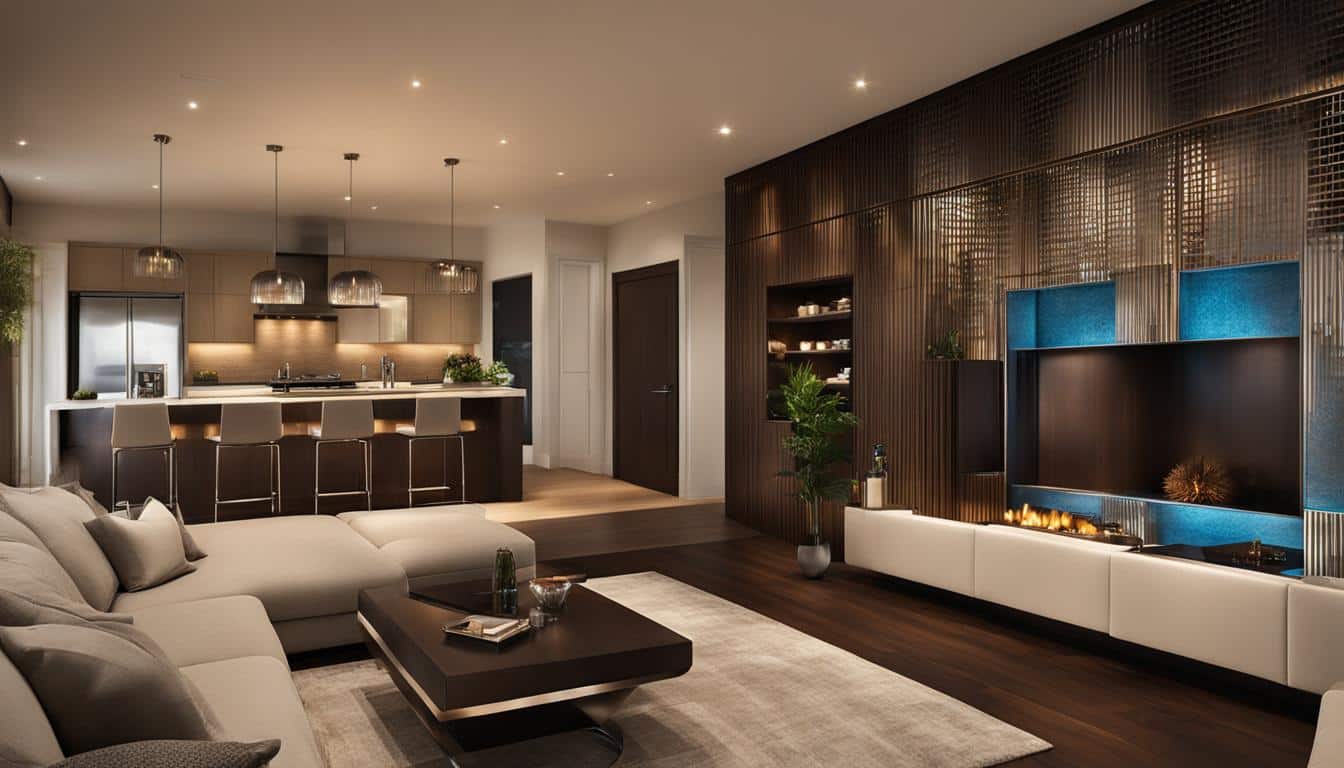Do you ever find yourself struggling to create the perfect ambiance in your home or business setting? If so, it’s time to consider the power of a well-thought-out can lighting layout. A proper can lighting layout, when paired with recessed lighting, can help you achieve the desired atmosphere while also modernizing your space. With the right guidelines in place, you’ll soon discover that the possibilities for your interior are endless.
Key Takeaways
- Proper can lighting layout can elevate the functionality and atmosphere of your space
- Recessed lighting is ideal for both ambient and focal point lighting
- LED bulbs and retrofits offer energy-efficient options for your lighting schemes
- Include both centralized and task-oriented light sources in your plan
- Consider utilizing dimmer switches for adjustable ambiance
- Layering decorative fixtures with recessed lighting creates depth and warmth
- Calculating wattage and light positioning is essential for a harmonious layout
The Brilliance of Recessed Lighting for Home Enhancement
Recessed can lighting design brings a polished, modern aesthetic to any living space while offering the practicality of task lighting, particularly in the kitchen. Recessed lighting for home seamlessly integrates with existing light fixtures, creating a cohesive ambiance and highlighting decor or architectural elements when not being used for direct tasks.
The Aesthetic and Practical Benefits of Can Lighting
Recessed can lights deliver a sleek, unobtrusive look, which enhances the overall ambiance of a room. Hidden behind the ceiling, can lights drastically reduce visual clutter and allow the room‘s design features to shine. Furthermore, these lights are highly adaptable, enabling homeowners to customize their illumination style to cater to various tasks and moods.
Can light spacing also plays a crucial role in achieving the desired light diffusion throughout a space. Properly spaced can lights ensure even distribution of light and help eliminate dark corners, providing an inviting atmosphere for any room.
LED vs. Traditional Bulbs in Recessed Lighting
When it comes to selecting the most suitable bulbs for recessed lighting, you must choose between LED bulbs and traditional bulbs. LEDs have gained popularity in recent years for their energy-efficient properties and long-lasting performance.
LED bulbs in recessed lighting consume less energy and have a longer lifespan compared to traditional bulbs.
Retrofitting existing lighting systems with LEDs offers an easy solution for homeowners looking to upgrade to more efficient and eco-friendly lighting options. This process allows you to modernize your lighting system without the need to modify current fixtures.
| Lighting Type | Energy Efficiency | Lifespan | Cost |
|---|---|---|---|
| LED Bulbs | High | Long-lasting (up to 50,000 hours) | Expensive upfront, but cost-saving in the long run |
| Traditional Bulbs | Low | Shorter lifespan (up to 2,000 hours) | Cheaper upfront, but higher energy consumption |
Ultimately, the choice between LED bulbs and traditional bulbs in recessed lighting depends on your individual needs and preferences. Considering factors like energy efficiency, lifespan, and long-term costs can help you make an informed decision for your home lighting system.
Creating a Cohesive Can Light Plan for Your Kitchen and Living Spaces
Ensuring a harmonious can light scheme for your kitchen and living spaces entails careful planning and consideration of the most utilized areas, like kitchen workstations or living room reading nooks. Integrating task lighting with general illumination and marking these specific areas in your plan will provide a guide for the strategic placement of recessed lights.
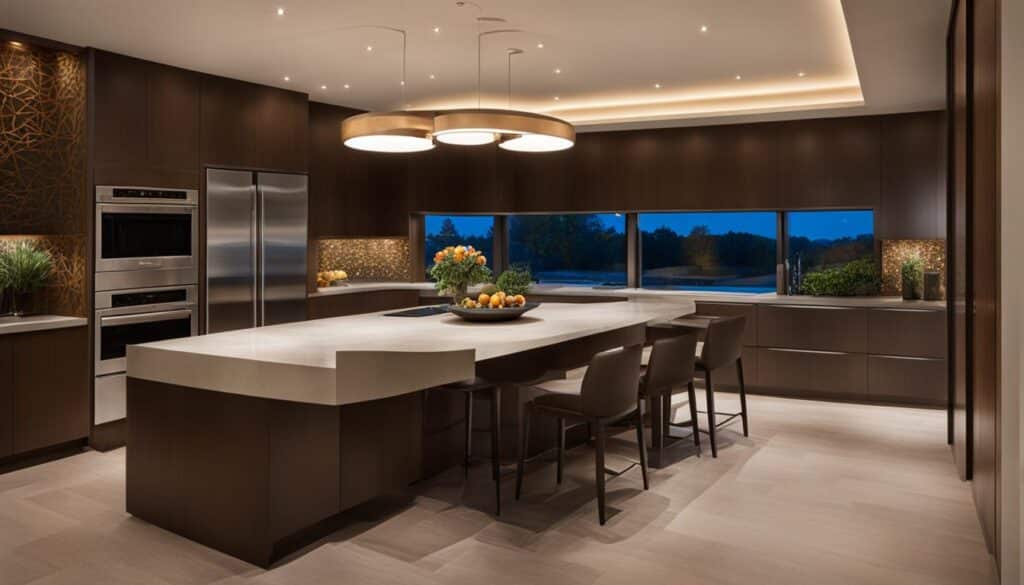
To determine how to layout can lights effectively, first identify the key areas within your kitchen and living spaces that require task and accent lighting. This includes countertops, cabinets, reading areas, and artwork displays. Once these areas are marked, consider the appropriate can light placement for each zone.
Pro Tip: Use a room sketch or blueprint to map out your can light layout for easy visualization of placement and spacing.
In addition to task lighting, your plan should also include general illumination, which can be achieved by evenly placing can lights throughout the space. This ensures consistent brightness and a comfortable atmosphere.
- Take accurate measurements of your room dimensions, ceiling height, and any existing light fixtures.
- Sketch a bird’s-eye view of your space, marking the key task and accent lighting zones.
- Choose suitable can light spacing based on your ceiling height and room layout.
- Using your room sketch, plan the placement of can lights for optimal illumination and a cohesive lighting design.
Creating a well-rounded can light plan involves not only perfecting placement but also considering the right combination of task, accent, and general lighting. By following these guidelines, you will achieve a harmonious, functional, and visually appealing lighting scheme for your kitchen and living spaces.
Enlightening Your Space: Choosing the Right Bulb
The type of bulb chosen for recessed lighting drastically impacts the overall ambiance and mood of a space. LEDs cater to an array of atmospheres with their adjustable brightness levels and color temperatures, presenting a plethora of lighting possibilities for various settings.
The Impact of LED Bulbs on Ambiance
LED bulbs offer a versatile lighting solution, allowing you to achieve the perfect illumination for any room. With the ability to adjust brightness levels and color temperatures, LED bulbs can create anything from a cozy and warm atmosphere to a vibrant and energizing environment. To further demonstrate the advantages of choosing LED bulbs over traditional options, consider the following table:
| Lighting Feature | LED Bulbs | Traditional Bulbs |
|---|---|---|
| Energy efficiency | High | Low |
| Lifespan | Long | Short |
| Color temperature options | Wide range | Limited |
| Brightness adjustability | Highly adjustable | Less adjustable |
As shown, LED bulbs offer a superior lighting experience both in terms of efficiency and adjusting the ambiance within your space, making them the ideal choice for can lighting.
How Retrofitting Enhances Existing Can Lighting
Retrofitting can lighting with LED technology is an effective way to upgrade to modern standards without intensive renovations. LED retrofits provide enhanced energy efficiency and superior illumination, allowing you to enjoy the benefits of contemporary lighting solutions while still utilizing your existing can light systems. The retrofit process typically involves the following steps:
- Removing the old bulb and trim from the existing can light fixture.
- Installing the new LED retrofit unit, which consists of an integrated LED module and trim.
- Securing the unit in place by using the provided clips or springs designed to work with your existing can light housing.
In summary, retrofitting existing can light systems with LED technology allows for a seamless transition to energy-efficient lighting without sacrificing your established layout or design. This enhancement ensures you benefit from the savings and ambiance-enhancing features of LED bulbs, making it a wise investment for your home or business.
Master the Mood: Utilizing Dimmer Switches with Can Lights
Having the ability to control the brightness of your recessed lighting is essential to create the perfect atmosphere for any occasion. Dimmer switches with can lights enable you to adjust can light brightness, providing an ideal lighting level tailored to suit any event’s ambiance, whether it is an intimate gathering or a vibrant celebration.
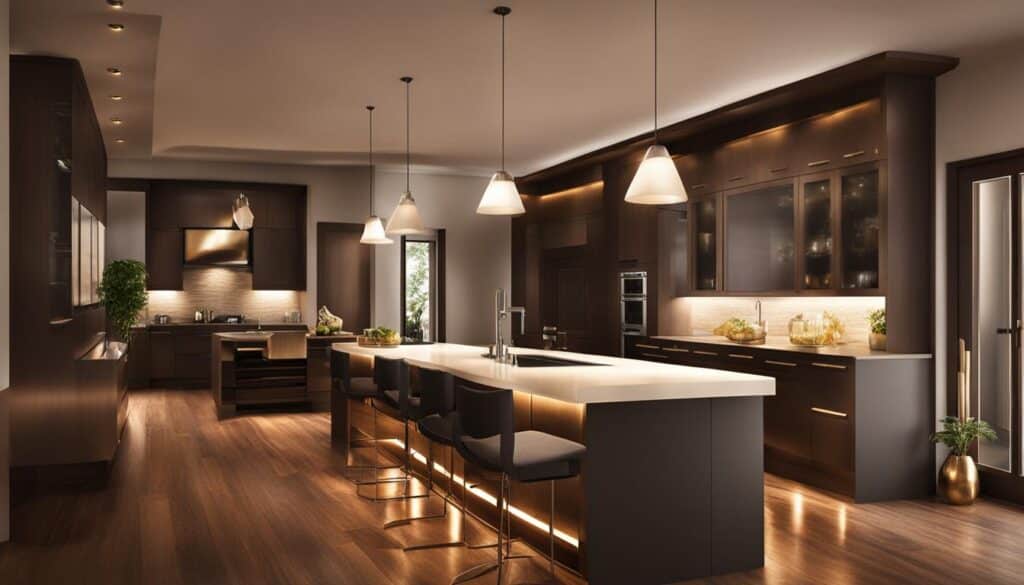
Dimmer switches offer numerous benefits to homeowners, including increased energy efficiency, prolonged bulb lifespan, and the ability to set the mood for various activities within your living spaces. Some noteworthy advantages of integrating dimmer switches with can lights are as follows:
- Energy and cost savings: Regulating the amount of light emitted translates to reduced energy consumption, ultimately resulting in lower energy bills and a smaller carbon footprint.
- Prolonged bulb life: Dimming your can lights reduces the strain on the bulbs, ultimately helping to extend their lifespan and decrease the frequency of replacements.
- Greater control over ambiance: Fine-tuning the intensity of your lighting allows you to create various moods within a space, enhancing the overall appeal and comfort of your living environment.
It is crucial to make sure that your dimmer switch is compatible with your chosen can light system before installation. Incorrect pairings can result in flickering or unresponsive lights, undermining the intended benefit of dimmer switches.
“By incorporating dimmer switches with your can lighting system, you can create the ultimate flexible environment, adapting your lighting to suit the individual needs of each space.”
Furthermore, proper implementation of dimmer switches should be complemented by thoughtful placement of can lights. This involves understanding the requirements of each room, tailoring the placement and density of lights to deliver the perfect balance between task-oriented and ambient lighting.
| Room | Recommended Can Light Density | Considerations |
|---|---|---|
| Kitchen | High | Provide ample illumination for food preparation and cooking activities, while maintaining comfortable ambient light for dining and relaxation. |
| Living Room | Medium | Strike a balance between task lighting for reading or working and ambient lighting for relaxation and socializing. |
| Bedroom | Low to Medium | Ensure appropriate lighting for getting dressed, winding down and reading in bed, without overwhelming the space with artificial light. |
| Bathroom | Medium | Facilitate a well-lit space for grooming and personal care activities, with a comfortable level for recreational bath times or relaxation. |
Once you’re equipped with the right dimmer switches and have carefully considered your can light placement, you’ll unlock the potential to create a truly personalized and captivating atmosphere in your home that caters to your unique preferences and lifestyle.
A Symphony of Light: Layering with Can Lights for a Warm Glow
Creating a captivating and inviting atmosphere for your interior spaces requires a carefully considered approach to lighting. Artfully layering can lights with decorative fixtures produces a well-rounded ambiance that is both cozy and versatile. This strategy offers an exceptional range of design possibilities, from emphasizing architectural details to fostering a warm, intimate environment.
Combining Decorative Fixtures with Recessed Lighting
Merging recessed can lights with decorative light fixtures gives you the freedom to create different layers of illumination. This combination is perfect for providing task lighting, accent lighting, and ambient lighting in various parts and corners of your home. Consider the types of lighting effects you want to achieve and how each layer will contribute to the overall look and feel of your space.
| Recessed Can Lights | Decorative Light Fixtures |
|---|---|
| Functional task lighting | Chandeliers, pendants, or sconces |
| Accent lighting for focal points | Table lamps, floor lamps, or wall lights |
| Ambient general lighting | Ceiling fixtures, recessed downlights, or track lights |
Accentuating Art and Architecture with Can Lights
Can lights serve as both functional and decorative elements within your lighting design, particularly when used to accentuate art pieces and architectural details. By focusing the light from recessed cans, you can draw attention to the finest elements of a room. This might include highlighting a grand fireplace, an impressive piece of artwork, or a sculptural detail within your space.
- Position can lights at a 30-degree angle to the artwork or architectural feature.
- Aim the beams towards the focal point, ensuring they’re concentrated and focused.
- Choose appropriate wattage and color temperature to enhance the visual impact of your artwork or architectural detail.
Layering can lights with decorative fixtures, focusing on valuable art or architectural elements, will ultimately achieve a harmonious, warm glow within your living spaces. Embrace the myriad of possibilities and let your imagination guide your creative journey.
Sketching Success: Planning Recessed Lighting Layouts
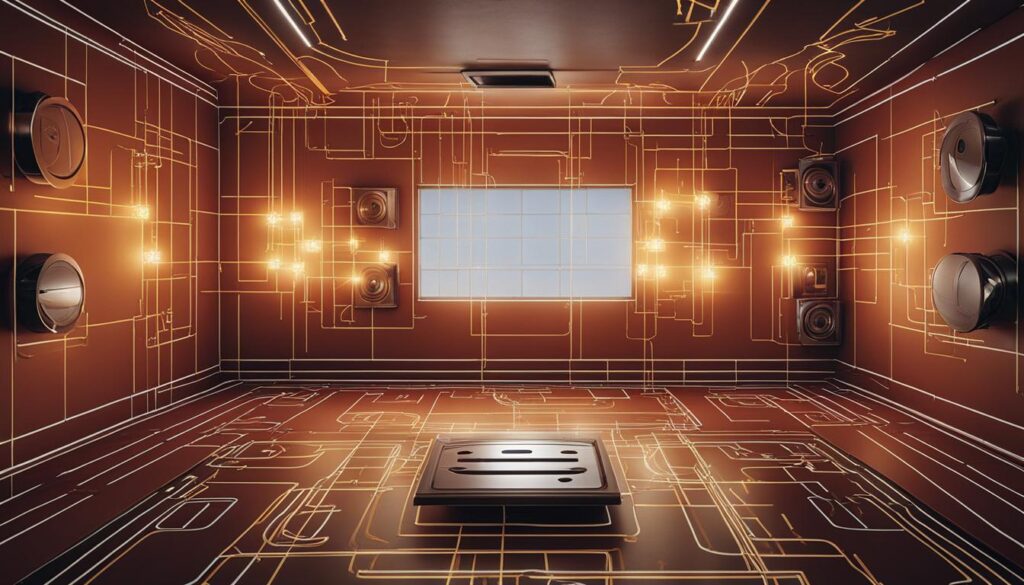
Creating a well-balanced and visually appealing recessed lighting layout requires careful consideration of room dimensions, furniture placements, and focal points. It’s essential to take these elements into account to effectively illuminate key features and create preferential visibility within the space.
Highlighting Your Furniture and Features with Light
When planning your lighting layout, it’s crucial to emphasize certain areas and create an ambiance that complements the overall room design. Highlighting furniture with lighting not only accentuates individual pieces but also helps to draw attention to the subtleties of a room’s aesthetic.
Here are some practical steps for planning your recessed lighting layout:
- Measure the room dimensions, including ceiling height and wall lengths.
- Analyze the furniture placement, considering where key pieces are positioned and how they might impact the overall lighting scene.
- Identify focal points, such as artwork, architectural features, or specific areas related to the room’s function.
- Sketch the desired lighting layout, including the location of specific can lights in relation to furniture pieces and focal points.
Pro tip: Take note of natural light sources – like windows and skylights – to amplify sunlight during the day and lessen the need for artificial lighting.
“The perfect recessed lighting layout not only enhances the atmosphere but also highlights the room’s character by drawing attention to key features and creating a cohesive visual narrative.”
By following these steps, you can create a visually striking and functional recessed lighting layout that accentuates your furniture, highlights your home’s unique features, and contributes to an inviting and comfortable environment.
Centered or Focused: Determining Your Can Light Placement
When it comes to can light placement, striking a balance between centered recessed lighting and focused lighting is crucial for achieving an optimal illumination level. By understanding the attributes of each lighting approach, you can effectively determine where to position your can lights to best suit the specific areas and tasks in your home.
If you want to light your space to perfection, understanding can light placement is an essential step.
Task-oriented areas, like kitchen countertops, benefit from strategically placed focused lighting. A well-designed layout ensures that all your work surfaces are bathed in light, making food preparation, cooking, and cleaning a breeze. In these instances, carefully positioned recessed lights offer the optimal blend of functionality and ambiance.
- Measure your countertop dimensions to identify primary work areas
- Account for any overhead storage or appliances that could block light
- Determine the optimal site for focused lights that won’t cast annoying shadows
On the other hand, centered recessed lighting is more suitable for general room lighting, particularly in living rooms and bedrooms. By adopting a more centralized placement approach, you’re ensuring a welcoming and comforting environment.”
Ultimately, striking a balance between centered and focused lighting ensures a harmonious blend of illumination throughout your space. It’s essential to assess and adapt your can light placement to suit each unique area and its requirements, paving the way for an ideal lighting scheme.
The Golden Rule: Ceiling Height and Light Spacing
One of the foundational aspects of configuring your recessed lighting is considering the ceiling height and light spacing. The appropriate distance between lights greatly influences the overall balance of illumination, and can make or break the aesthetic and functional utility of your lighting layout. A widely recognized guideline is to divide your room’s ceiling height by two in order to determine the optimal spacing between can lights.
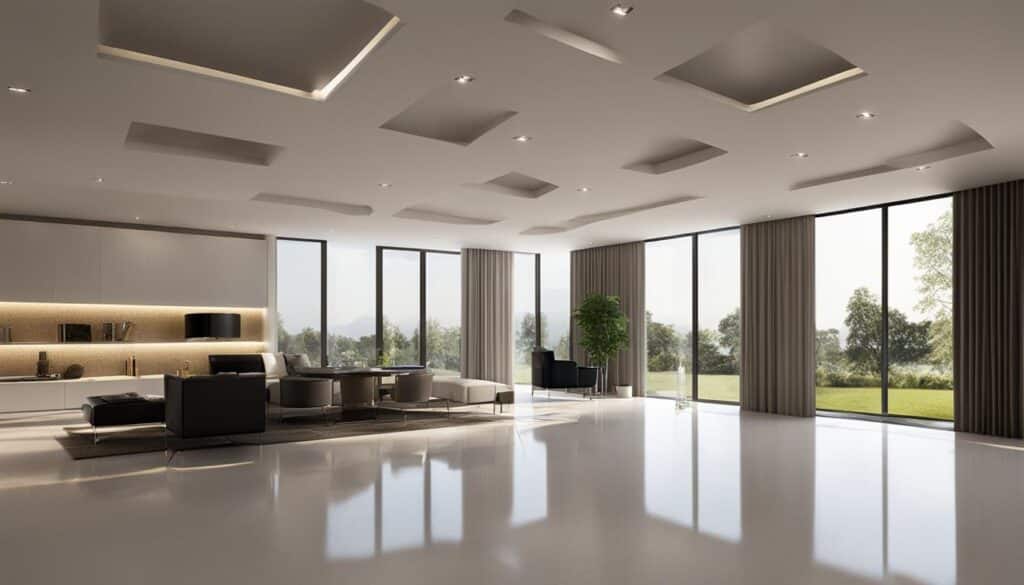
By adhering to this rule, you can avoid creating unsightly dark spots or overwhelming brightness levels that detract from the visually stunning atmosphere you aim to achieve. However, ceiling height is only one piece of the puzzle, as room usage and bulb brightness also contribute to the ideal recessed lighting spacing.
Spacing Revised: Considering Room Use and Bulb Brightness
It’s essential to take into account the specific use of a room when determining spacing for your recessed lighting. Consider, for instance, a room that serves dual purposes, such as a kitchen and dining area. In this case, the spacing of task lighting over kitchen countertops should be closer together, while the dining area may benefit from a different spacing configuration.
Moreover, the brightness of your chosen bulbs can also have an impact on the optimal spacing between lights. Brighter bulbs may necessitate greater distances between fixtures to prevent overpowering brightness, whereas dimmer bulbs may warrant closer spacing to maintain adequate illumination levels.
- Brighter bulbs: Increase spacing between can lights to avoid overwhelming brightness.
- Dimmer bulbs: Decrease spacing to ensure sufficient illumination in the desired area.
Room usage and bulb brightness should work in tandem with the ceiling height when determining the ideal recessed lighting spacing for your space.
Ultimately, by balancing ceiling height, room usage, and bulb brightness, you can effectively create a well-rounded lighting scheme for your home or office. Paying careful attention to these factors will not only enhance the visual appeal of your space but also ensure that your recessed lighting system caters to your specific requirements.
Shadow Play: Avoiding Dark Corners in Can Lighting Design
When it comes to crafting the perfect ambiance within your living space, one critical aspect to consider is how to avoid the formation of uninviting shadows, especially in corners. Careful placement of can lights not only minimizes dark corners, but also contributes to a more inviting and spacious feeling in your home. In this section, we will explore a few key points to consider for your recessed lighting design to ensure you avoid those problematic areas.
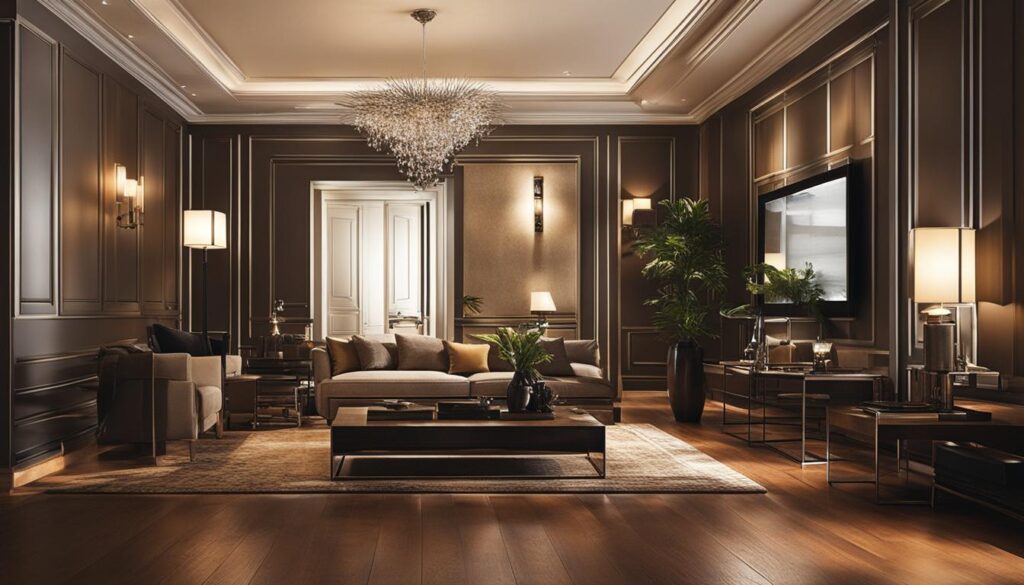
First, it is essential to assess the layout of your space and identify potential spots where shadows might form. To accomplish this, make note of the following:
- Furniture arrangements
- Wall and ceiling features
- Existing light sources
Once familiar with these aspects, consider how the placement of your can lights can work harmoniously to illuminate the entire area effectively.
Remember: Proper can light spacing is key to achieving an evenly distributed and visually appealing lighting design.
Now, let’s examine some pivotal tips to avoid dark corners:
- Distance from walls: Ensure that can lights are positioned at an appropriate distance from walls to minimize shadows. Aim for a distance of approximately 2-3 feet for most rooms.
- Overlap beams: By overlapping beams from adjacent lights, you can create a more uniform distribution of light throughout the space, effectively eliminating dark corners.
- Adjustable trims: Utilizing adjustable trims for your recessed lighting allows you to direct the light beam precisely where you need it, ensuring comprehensive coverage and enhanced flexibility.
Ultimately, a well-thought-out recessed lighting design that takes into account potential shadow formation will elevate the overall ambiance of your home. By avoiding dark corners and providing uniform light distribution, your space will feel both inviting and spacious – a true testament to the power of impeccable can light placement.
From Blueprint to Brilliance: Finalizing Your Can Lighting Layout
Now that you’ve sorted out the ideal placement of your can lights, calculated the proper amount of light for your space’s needs, and considered layering options for a harmonious ambiance, it’s time to put everything together. Finalizing your can lighting layout is a crucial step to help you achieve the desired lighting intensity and encompassing harmony within a given space.
Calculating Wattage and Adjusting Light Placement
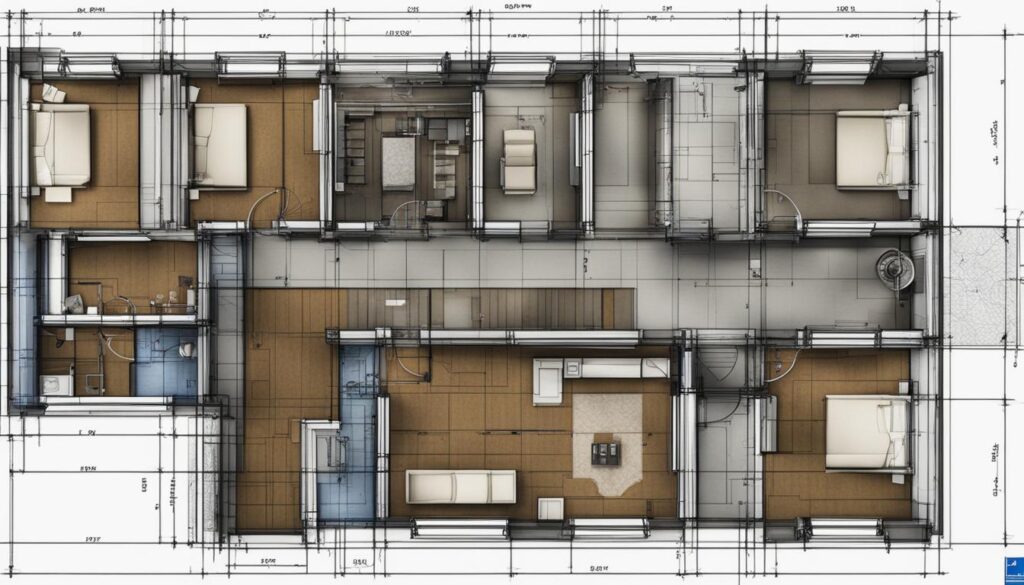
To calculate lighting wattage, you want to make sure that your recessed lighting setup provides an adequate amount of illumination without overpowering the space. It’s important to consider the combined wattage of all light sources in the room and how they work together to create an ideal balance of light.
- Determine the required amount of lumens – Lumens are used to measure the brightness of a light source. Check the requirements per square foot for your room’s intended use.
- Estimate the number of can lights needed – A ballpark figure will be useful in calculating wattage. Bear in mind that the number may change after finalizing your layout.
- Calculate total wattage – Multiply the required lumens per square foot by the room’s square footage. Then, divide this number by the quantity of can lights to identify the wattage per bulb.
With the wattage calculated, you may need to adjust can light placement before finalizing your layout. This is a vital step to ensure an evenly distributed glow and prevent unwanted dark spots. Consider the following adjustments:
- Reposition can lights closer to walls to eliminate dark corners.
- Alter distances between task and accent lights to create a balanced illuminative hierarchy.
- Revise the alignment of can lights to better match dimensions and functional zones.
Remember, each space is unique and may require specific adjustments for optimal results. Experiment with different recessed lighting arrangements to find the perfect harmony between illumination and aesthetics.
In conclusion, successfully finalizing a lighting layout is a testament to your attention to detail and thorough planning throughout all the previous steps. By meticulously calculating wattage and tactically adjusting lighting placement, you’ll be well on your way to enjoying a space that boasts perfect ambiance, functionality, and aesthetic appeal.
Conclusion
As I reached the culmination of my can lighting layout journey, I grasped the powerful impact of combining both aesthetic and functional choices. The key to unlocking a perfect ambiance in any interior space lies in the intricate balance of selecting the right bulbs, perfecting their placement, and leveraging clever controls such as dimmer switches. With the right can lighting layout in place, every corner of your home or business establishment will exude a warm, inviting, and cohesive glow.
Like a symphony conductor, I have learned the art of orchestrating the elements of a recessed lighting setup for a harmonious result. With careful planning and attention to details like ceiling height, wattage requirements, and avoiding dark corners, I transformed my space into a well-illuminated haven that blends both function and form.
All in all, the process of can lighting layout completion has not only enhanced the visual appeal of my home, but has also improved its energy efficiency and functionality. The satisfaction of achieving a well-rounded and visually stunning environment is invaluable and serves as a testament to the power of a thoughtfully designed recessed lighting setup.
FAQ
What are the benefits of can lighting?
Can lighting provides a streamlined, contemporary appeal and delivers the flexibility to serve as task lighting, especially in the kitchen. It complements other light sources and can highlight decor or architectural features when not being used directly for tasks.
What is the difference between LED and traditional bulbs in recessed lighting?
LED bulbs have risen to prominence for their energy-saving properties and longevity, while retrofitting allows for an easy upgrade of existing lighting systems to LED, ensuring modern efficiency without the need to alter existing fittings.
How do I create a cohesive can light plan for my kitchen and living spaces?
Ensure a harmonious can light scheme by carefully planning and considering the most utilized areas, like kitchen workstations or living room reading nooks. Integrating task lighting with general illumination and marking these specific areas in your plan will provide a guide for the strategic placement of recessed lights.
How do LED bulbs impact the ambiance of a space?
LEDs cater to an array of atmospheres with their adjustable brightness levels and color temperatures, presenting a plethora of lighting possibilities for various settings.
What is the role of dimmer switches in can lighting?
Dimmer switches provide an essential element of control over recessed lighting, allowing the adjustment of light intensity to match the desired mood or occasion. This ensures an ideal lighting level for any event’s atmosphere.
How can I combine decorative fixtures with recessed lighting for a warm glow?
A well-rounded and inviting ambiance can be achieved by artfully layering light sources, including recessed can lights and decorative fixtures, allowing for versatility in lighting design.
How do I plan a recessed lighting layout?
Planning a recessed lighting layout requires the careful identification of room dimensions, furniture placements, and focal points. By translating these variables into a lighting plan, one can effectively illuminate key features and create preferential visibility within the space.
How do I determine the best can light placement?
When determining can light placement, a balance between centered and focused lighting should be achieved. For task-oriented areas such as kitchen countertops, strategically placed recessed lights provide optimal illumination. Conversely, for general room lighting, a more centralized placement approach is appropriate.
What is the guideline for can light spacing based on ceiling height?
The guideline for can light spacing is dividing the ceiling height by two. This helps determine the appropriate distance between lights for a balanced spread that accommodates both aesthetic and functional needs.
How can I avoid dark corners in my can lighting design?
To avoid the formation of uninviting shadows, especially in corners, can lights should be thoughtfully spaced. Properly placed, these lights can enhance a room’s sense of space and ensure a uniform light distribution, contributing to an inviting and spacious feeling.

